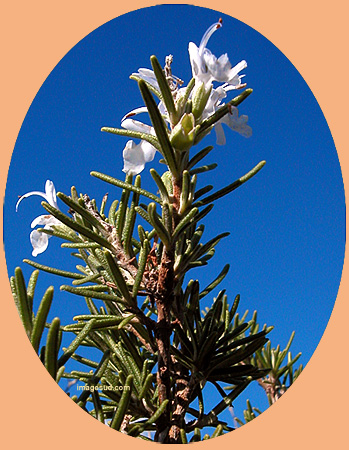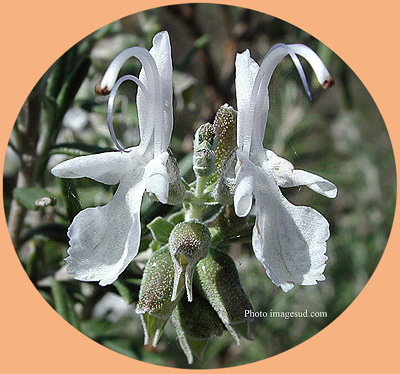
ROSEMARY, SALVIA ROSMARINUS = ROSMARINUS OFFICINALIS, LABIATEAE=LAMIACEAE is a Mediterranean plant.
It is a shrub, quite bushy, with small and narrow leaves with their upper surface convex a little shiny, the interior concave and white.

The flowers are discreet, purple, sometimes lighter or even white, typically bilabiate with two clearly visible stamens.
Like thyme or mint, rosemary is now widespread in many countries with temperate, subtropical and even tropical climates.

ROSEMARY SALVIA ROSMARINUS ROSMARINUS OFFICINALIS FOR THE BILIARY TRACT ESSENTIAL OILS ANTISEPTICS AND TONES MEDICINAL PLANT ANTI INFLAMMATORY AGAINST FREE RADICALS PREVENTION OF CANCER
CHEMICAL COMPOSITION AND PROPERTIES
The very particular smell of rosemary, slightly camphorated but softened by a pine scent, is of its the essential oil present in the leaves.
It is found from 1 to 2% depending on the cultivation conditions, a complex mixture dominated by cyclic monoterpenes (camphor 15% to 25%, cineole 15% to 30%, pinene 25%, borneol 15% to 20%).
We classically distinguish 3 types of essential oils according to their dominant component:
- The essential oil of rosemary with camphor contains about 20% of camphor and as much of 1-8 cineole (eucalyptol) and alpha-pinene.
- The essential oil of rosemary with cinèole (= eucalytol) which contains 50% of 1-8 cineole and 10% of camphor and alpha-pinene.
- Rosemary verbenone essential oil: the major constituent of which is in fact 25 to 30% alpha-pinene (chemical precursor of verbenone), approximately 10% of camphor and 8 to 10% of verbenone.
ROSEMARY ESSENTIAL OILS with camphor and verbenone
They are:
- are skin antiseptics,
- activate the functioning of the liver and biliary excretion,
- are anticatarrhals and antiseptics of the respiratory tract,
- are antispasmodic (spasmolytics) and muscle relaxants
- and stimulate the heart, breathing (camphor = analeptic cardio-respiratory) and the central nervous system (risk of hyperexcitation and insomnia).
BUT BE CAREFUL, essential oils with ketones (especially in rosemary, bicyclic monoterpene ketones) are known for their neurotoxicity and their ability to trigger an epileptic fit (epileptogenic) hence caution in their oral use.
ROSEMARY ESSENTIAL OIL with cineole
This rosemary essential oil:
- is an antiseptic for the respiratory tract and facilitates expectoration,
- is an antiseptic for the urinary tract and digestive disinfectant,
- it seems to reactivate the hair follicles, especially in the case of localized alopecia areata (localized alopecia = alopecia areata)
THE ROSEMARY LEAF
The leaf and flowering branches of rosemary also contain other very interesting components from a pharmacological point of view:
- rosmanol, carnosol and carnosic acid (phenolic diterpenes),
- flavonoids, phenol acids (in particular rosmarinic acid) ,
- triterpenes with a steroid structure (oleanic acid).
All these compounds are studied for their medicinal properties:
- anti-inflammatory
- anti-cancerous
- anti-oxidant (scavengers of free radicals)
- protector of the hepatic cell
Rosmarinic, carnosic and carnosol acids, antioxidants, anti-inflammatories, protectors against cancer
Rosmarinic acid is a powerful anti-oxidant scavenger of free radicals and is attributed to it an anti-viral and antibacterial power as well as an anxiolytic activity (by interaction in the metabolism of gamma amino-butyric acid (GABA) at the like benzodiazepines such as librium or valium).
Experiments prove that rosmarinic acid is absorbed digestively and is found in the blood long enough to work before it is broken down and metabolized.
Carnosic acid is also very antioxidant and decreases the action of free radicals.
Carnosol is also antioxidant and anti-inflammatory, recent studies show that it is a substance which, when it is present in food on a regular basis (as in the countries around the Mediterranean), reduces the risk of development of many cancers; prostate, breast, skin, colon, leukemia.
Carnosol is perhaps a protector of neurons and it is possible that it thus delays the development of degenerative diseases of the brain including Alzheimer’s disease
ROSEMARY EXTRACTS: alcoholic tincture and aqueous extract
The hydroalcoholic extract (ethanolic tincture) is cholagogue and hepatoprotective in vivo in rats (but at high dose) and, in vitro, scavenger of free radicals and hepatoprotective (anti-lipoperoxidant action, prevention of necrosis of isolated hepatocytes (liver cells).
The ethanolic tincture of young shoots of rosemary seems more effective than that of the whole adult plant.
Rosemary (hydroalcoholic extract and to a lesser extent its aqueous extract) is considered to be an effective drainer of the bile ducts, it is also a diuretic (aqueous extract).
USES
ROSEMARY A MEDICINE FOR THE BILIARY TRACT
Rosemary is first and foremost a drug for the biliary tract and for disorders linked to a malfunction of the gallbladder: intolerance to fats, eggs, constipation or fatty diarrhea, slow digestion with headaches.
We can recommend:
- alcoholic tincture of young shoots or glycerine maceration of young shoots, 20 to 100 drops per day,
- prolonged infusion of fresh or dry plant: 1 teaspoon of dry leaves or 1 small twig of rosemary per cup of very hot water, let infuse 10 minutes, 2 to 3 cups per day,
- capsules dry plant or the already ready-made mixture of plants for cholagogue in herbal tea, capsules or in the form of hydroalcoholic extract (some pharmaceutical specialties were put on the market in 1941!)
GENERAL STIMULATING ROSEMARY
Rosemary is also a general stimulant, especially through its essential oil to recommend in cases of asthenia, general fatigue or for the elderly: eg, 1 drop of essential oil of rosemary with cineole 3 to 4 times a day.
Be careful not everyone reacts the same way, some people can see their blood pressure drop with a tendency to dizziness, faintnes
ROSEMARY AND ITS ESSENTIAL OIL
The essential oil of rosemary with cineole:
- is a good treatment of respiratory infections following a seasonal viral infection: 2 drops 2 to 3 times a day
- it is also recommended in application on the scalp in the event of alopecia of alopecia areata, pure or diluted in vegetable oil.
- this essential oil is a disinfectant in particular digestive, often in association with other essential oils (cinnamon or mint or geranium), be careful to not overdose.
- Locally, it is a healing and antiseptic essential oil useful for reducing the pain of shingles (direct application to the vesicular rash) or for disinfecting the mouth (gargling or mouthwash: a few drops in a glass of lukewarm water that one tries to mix before using).
ANTI OXIDIZING AND ANTI INFLAMMATORY ROSEMARY
The aqueous extract or the ethanolic tincture are useful by their anti-free radical power:
- to facilitate smoking cessation
- to delay general aging (including the occurrence of certain cancers)
- and also to control disorders related to hypercholesterolemia or blood dyslipidemia (atheroma and arteriosclerosis).
- The prolonged infusion-decoction (two tablespoons in 1/2 liter of water 2 minutes of boiling and 20 minutes of infusion) can be used as a mouthwash, in application on irritated skin and even as a vaginal injection (leucorrhoea)
ROSEMARY IN FOOD
Rosemary is a very popular and easy to find condiment, it can be added to many dishes but also in the cooking water of pasta, rice or vegetables, in high doses it can be a little bitter.
It is advisable to regularly use in the kitchen various Mediterranean labiae to maintain the body’s immune defense high and to delay the aging of the body’s tissues (anti-free radical action).
ROSEMARY EXTRACTS IN FOOD AND PERFUMES
Rosmarinic acid and carnosic acid are used as preservatives (anti-oxidants) in the food and cosmetic industries.
The aromatic extracts of rosemary (essential oil or « essence » of rosemary, rosemary alcoholate) are widely used in perfumery (such as the very old « water of Hungary or many » colognes « ) and the cosmetics industry.
ROSEMARY CULTIVATION
Rosemary is an easy to grow, very hardy, evergreen bushy plant that is drought tolerant but does not like cold, wet soils.
It is propagated by cuttings or sowing (more difficult).
There are many varieties of rosemary (varied adaptation to the climate, more or less rapid growth, flowers of different sizes and colors, variable aroma depending on the composition of the essential oil).
Finally, rosemary is a good honey plant very popular with bees.
ABSTRACT
A CONDIMENT TO DRAIN THE BILIARY TRACT
Rosemary, with its aromatic foliage reminiscent of frankincense and pine, contains substances that facilitate the excretion of bile in the intestine, thus promoting the digestion of fats and intestinal transit.
Its essential oil is antibacterial, stimulating but can be toxic in exaggerated doses.
Rosemary contains substances with very interesting pharmacological potential and it is a plant to be used in food for its anti-free radical power..
Copyright 2023 : Dr Jean-Michel Hurtel
You are on www.phytomania.com
French site dedicated to medicinal plants and essential oils
PHYTOTHERAPY, AROMATHERAPY, MEDICINAL PLANTS, ESSENTIAL OILS